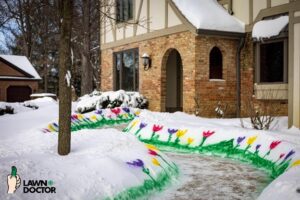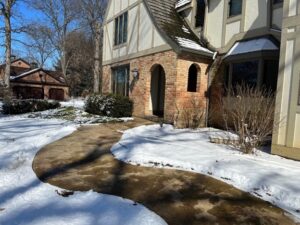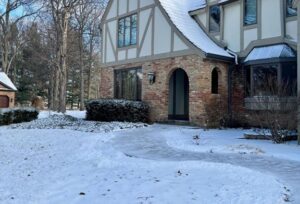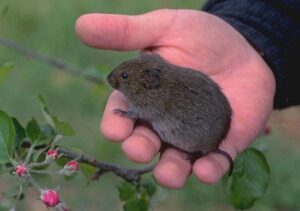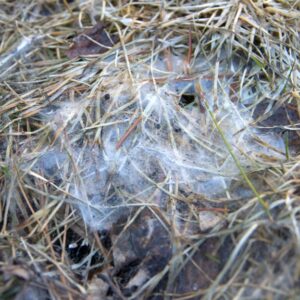I know that we are all yearning for Spring by this time every year. This year, we have actually felt like Spring is HERE in February.
In most of our area, we have had SIGNIFICANTLY less snow in the 2022/2023 winter and it will melt quickly.
(In the photos above you can see that we have NOT had enough snow this year for February “snow flowers,” but we HAVE seen some Spring annuals already start to bloom prematurely.)
I said last year that we had had less severe cold over winter, but we have seen that even more this winter. The colder air temperatures today have resulted in a slightly lower “growing degree day” (11 today versus 15 a year ago) than last year, however the soil temperatures at this point (around 31 degrees) are identical to this day last year. (Purdue explanation of growing degree days)., however, you can see that our soil temperatures over the winter has stayed significantly warmer than normal.

(https://www.greencastonline.com/tools/soil-temperature)
When we decide the appropriate time to start Spring lawn treatments, we are looking at both the soil temperatures AND the growing degree days.
The Illinois State Water Survey compiles data on the average soil temperatures over the years by date: https://www.isws.illinois.edu/statecli/Soil-Temperature/soil_temperature.htm
You can read here to learn more about lawn care these trends from our Illinois State Climatologist: https://stateclimatologist.web.illinois.edu/2023/02/01/a-very-mild-start-to-2023/
As you can see below, for our area, we will usually start to see the soil warming trend starting in late March into April, even if we still see some additional cold temperatures or more snow.

https://www.isws.illinois.edu/statecli/Soil-Temperature/soil_temperature.htm

https://warm.isws.illinois.edu/warm/soil/
What are the effects of snow on your lawn and landscapes?
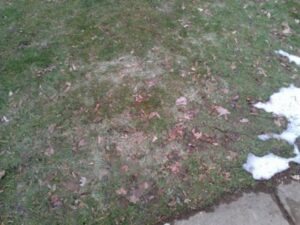
Snow has several benefits for your yard and your plants.
The biggest benefit of a good snow cover is that the snow functions as an excellent insulator of the soil. In winters with very little snow, the very cold temperatures freeze the soil deeper and deeper, which led to damage of root systems of trees and shrubs, and damage to uncovered plants. We did not see this over this winter.
The insulation effect of snow also helps protect perennials, bulbs, ground covers, and other plantings from alternating freeze/thaw cycles.
Without snow, milder temperatures and the sun warm the soil surface, and lead to damage from soil heaving, which can break roots and dry out plant parts.
Snow cover can help to conserve soil moisture over the winter, but with less snow, we do have dry soil in some areas. Even with some rain recently, quite a bit of our area is still considered “neutral” to “abnormally dry” at drought.gov and the long-range spring forecasts are predicting dry conditions to moderate drought for our area.
Many years we have concerns about salt damage or plow damage and snow mold. These are not expected to be big concerns this year. Vole damage has been an issue this winter already but is not expected to be as severe as in winters with longer snow cover. Here is some information on what we could see as the soil temperatures warm further, and the turf starts to wake up:
-
-
- Salt damage and plow damage to the turf near driveways and sidewalks
- Snow mold- this will be a significant concern this spring. You can read more here: https://turf.purdue.edu/snow-mold-damage/ and see below for some tips to help. In most cases, fungicides are NOT necessary or appropriate.
- Vole (field mouse) damage is expected to be significant due to the snow cover. See more info here: https://www.agry.purdue.edu/turfnew/tips/2007/voles.htm and tips below.
-
- While “Winterkill” of the turf from desiccation (drying out), direct low temperature damage, and ice encasement should not be as severe due to less severe cold, we may still see issues with crown hydration during the coming months. You can read more about these phenomena here: https://extension.psu.edu/winterkill-of-turfgrasses. (This will be a big issue in Southern states with warm-season grass due to the SEVERE cold spells they faced this winter. If you have friends or family that have been hit by the cold in the south, you can share this article with them: https://hgic.clemson.edu/winter-damage/ & https://gardeningsolutions.ifas.ufl.edu/care/weather/treating-cold-damage.html)
Important tips for your lawn and landscape going into Spring
- Protect the Lawn During the Last Weeks of Winter – This is not MUCH of a concern this year, but… TRY to protect your grass from regular traffic and snow piles through the last stretch of the season. Keep your driveway, sidewalks and paths clear of snow so that people have a safe place to walk. When possible, AVOID shoveling snow onto the lawn or making snow piles that get in the way, forcing people to trample down the grass.
- Re-distribute Snow Piles – Again, this is not a concern this year. In most lawns, we had seen complete snow melt prior to yesterday’s snow, but, where needed, as air and soil temperatures rise break up piles of ice and spread the snow around to help it melt away quicker. The existing turf and new grass growth can easily be damaged by the pressure from feet or piled snow. In addition, piles of snow take longer to melt and can block the grass from getting those first warm rays of sun in the early spring. The matted down grass with excess moisture can be a prime area for snow mold and can result in the grass taking longer to turn green and start growing.
- Rake to clear debris & help air circulation – It will be common to see matted down, brown dormant grass, along with debris and dead leaves once the snow is gone. Lightly rake the lawn to help perk up the turf to break up matted down areas and improve airflow to the surface of the blades. You can carefully clear away leaves and dead grass using a regular leaf rake, but make sure to wait until the ground has dried out and firmed up. Walking and working on the muddy turf can risk damage. Be gentle! Aggressive raking can pull fragile grass before it gets a chance to recover from dormancy and start to grow.
- Make your yard inhospitable to Voles– If you are seeing vole tracks in the turf, clear debris and leaf piles in the landscape beds and around trees where they may be hiding. Gently rake dead grass and chop up the tracks to disturb their pathways. In most cases the turf will recover fully.
- Gently brush heavy snow off shrubs – Heavy snow and ice can cause damage to shrubs. Roughly removing the snow and ice can cause branches to break off. As the temperatures warm up, use care to clear the snow from landscape plantings, when applicable.
- Consider Spring Aeration – Aeration is always a good idea with our turf and clay soil. Snow cover can further compact the soil which can compress roots and choke root growth. Mechanical Core Aeration and Liquid Aeration are both good options. If you shady areas liquid aeration is a better option. Here is more information on aeration options Liquid vs Mechanical Core Aeration: https://conta.cc/2Wg9hev
Best of all, we offer service in the following areas:
- Charles
- Naperville
- Batavia
- Wheaton
- Downers Grove
- Glen Ellyn
- Aurora
- Lisle
- Lombard
- West Chicago
- Winfield
- Geneva
- And throughout the surrounding area
Contact us today to get started with a free consultation and to find out more about our lawncare services in St. Charles, IL.
